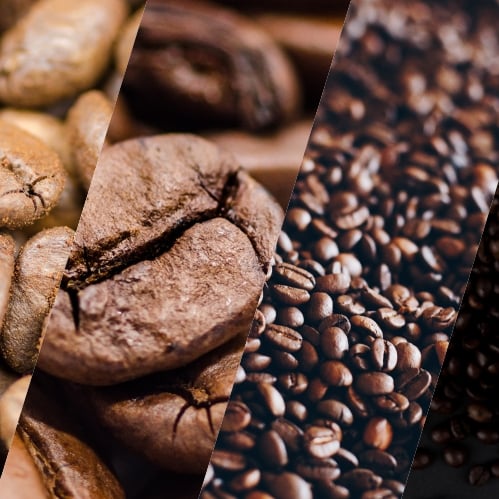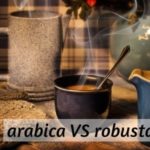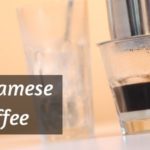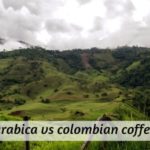When looking to get yourself a bag of coffee from the supermarket, you've probably noticed the is more than just one coffee bean type. You've probably seen the country of origin sometimes, a Robust mentioned here, a 100% Arabica there.
But how many coffee bean types are there ? If you care what kind of coffee you drink, then you've probably got a headache from all the mixed information out there on coffee types.
And the labels on the coffee bags don't help either. So let he help you out here, and settle the whole affair.
Table of Contents
There are 2 main types of coffee bean
I wrote this article specifically for people who don't really know the differences between the main coffee types, and the name of Costa Rica or Brasil don't recall a certain type of coffee.
That was me in the beginning, and I'm sure there are many coffee lovers out there who could benefit from this information. Often you'll find this info scattered randomly across the internet.
So I've made sure I collected, researched, and curated the info into a digestible and easy to follow guide
This leaves us with the 2 main types of coffee beans out there. Oh you'll hear about more than 2, but there are 2 sisters, so to say. And every other coffee bean aside from them is a subspecies of one or the other. So they're like 2 aunts with a whole slew of cousins, if you will.
Arabica is the most common, and most loved
Arabica coffee (also known as Typica) is what you'll find most often in your cup of coffee. This is the coffee that originated from Ethiopia way back when. Some might argue it was first found in Yemen.
In truth is was found and domesticated in Ethiopia, and shortly thereafter brought to Yemen, and that is where it was made popular in the port city of Mocha.
Arabica coffee is the less caffeinated version of coffee, as it contains only 1.5% caffeine. It happens to be a sweeter, and fattier kind of bean than the Robusta sister.
This produces a more flavorful, and milder tasting coffee which many people enjoy. Overall, Arabica and its subspecies are about 60% of the total global coffee production.
Arabica coffee beans are susceptible to disease and pests, which is a sore point of the coffee industry's history. We;ll cover that in a bit.
But in short, Arabica is tastier, with a frailer health than her Robusta sister, and is the one most prone to producing subspecies and also picking up flavors from the native soil in which it's grown.
Arabica is also the kind of coffee that works great as just black coffee if you're so inclined.
The growth necessities for Arabica are quite specific, seeing as it needs a yearly average of about 21 C/70 F to thrive, humidity, both sunshine and shade, and high elevation.
Not many countries can offer this kind of landscape and climate, but there are a few winners and the coffee industry has made taken note of them. That's the Coffee Belt, and we'll touch on that in a bit as well.
Robusta is the hardier, more resistant bean
Robusta too was originally from Ethiopia, but wasn't recognized as a separate bean until about 100 years after Arabica. Its name comes mainly from the fact that it's so resistant to pests and diseases, so it ends up producing larger crops every year, compared to Arabica beans.
The downside though is that Robusta has a much harsher taste, which is not okay for many folks out there. Often it's said to resemble burnt tires and dirt, but a part of that is also influenced by the roasting style.
Do take into account the fact that Robusta has less than half the sugar and fat content of Arabica, but double the caffeine (2.7%) and you'll begin to understand why it's not a favorite among the general population.
Robusta is often used as a filler, or as a cheap way to make decaf and instant coffee. I say cheap because Robusta has a larger yield and isn't as sensitive as Arabica. This makes it easy to grow and thus process, sacrificing a good portion of the quality for quantity.
When it comes to espressos, Robusta seems to be a preferred bean though. This is because its chemical makeup helps it produce a larger amount of crema, that espresso is meant to make.
Seeing as Robusta has such a strong taste, it's also more recommended for iced lattes since the coffee flavor will shine through, and the brew will be stronger than an Arabica by default.
At times, you will find coffee blends with Arabica and Robusta mixes. This is done to balance out the taste with the caffeine content, seeing as Arabica is lower in caffeine.
A few subspecies of coffee are grown for commercial use
There are quite a few subspecies of both Arabica and Robusta coffee beans. And they're rarely mentioned as being subspecies, partly because they have their own names, and partly because people actually do not know.
So for example you can find a "100% Arabica" bag next to an "Arabica and Blue Mountain blend" and rightly assume that Blue mountain is a separate type of coffee than Arabica.
When you want to delve deeper into coffee, this lack of properly organized information and labels can be very confusing, and sometimes lead you to unfortunate choices.
So here are a few common subspecies that you will also find in the supermarket and in specialty shops. There are many more than just these subspecies, but these are the ones that first come to mind, thus most common.
Liberica
It was brought into the Philippines when the Coffee Rust disease decimated the Arabica crops. This coffee has a woodier taste, a bit on the smoky side. It has flowery notes as well, but coming by this kind of coffee is fairly difficult.
Mostly because at one point the U.S. cut off supplies to the Philippines, and the coffee farms suffered in the process. Some farms still do exist, though they produce a small amount each year.
Excelsa
This is a rarer form of coffee than Liberica, and it was even incorporated into the Liberica family recently. How you view it doesn't matter in the end, as this kind of coffee as a taste of its own.
I've never had it myself, but it's meant to taste like a light and dark roast at the same time, with tart fruity notes.
Blue Mountain
Grown only in Jamaica's Blue Mountains, this kind of coffee is not very bitter, and has a sweeter side to it. It's a mutation of the usual Arabica coffee.
Bourbon
An Arabica subspecies that is grown mostly in Reunion Island in the Indian Ocean. It mutated and produces its own flavor, and after a while it was introduced to East Africa (1897). There it is known as French Mission, since it was introduced by French missionaries to that area. In Rwanda Bourbon is known as Mayagurez.
Catimor
This subspecies is a cross between Caturra and Timor subspecies, which are both Bourbon subspecies. This is a story that is common in coffee bean genealogy, and you will find many strains that are only sightly different from the original yet have a different name.
For a more comprehensive list of the different bean varieties and where they grow you can check out the dedicated Wikipedia page.
(If you like this article so far, you can pin it to your Pinterest board by clicking the image below. The article continues after the image.)
Why the coffee industry diversified its beans
You might be wondering why we've come to such a large collection of bean types, and how Robusta came to rise if it's not that great of a coffee to begin with.
Well, it started with the fact that Arabica is a very sensitive plant. I'm talking mostly about pests and diseases, but also about sunshine and direct sunlight and shade and general living conditions.
It's a fairly taxing plant to care for, and it only flowers a few years (3-5) after it's first planted, and when it does flower and then produce the coffee cherries there aren't many.
Arabica produces a much smaller yield than Robusta coffee, which means many plants are needed.
So, one fateful day in 1867 the Coffee Rust disease made itself known in Sri Lanka, then known as Ceylon (hence Ceylon tea btw). Originally the fungus is from Ethiopia, and how it got all the way to Sri Lanka is unknown.
The point is that large coffee farms were rendered useless, seeing as Arabica is easy to infect and to this day there is no known cure.
As such, Robusta started to be planted in the places where Arabica was infected, in the hopes of driving away the fungus. It worked, and now large parts of Asia owe their Robusta crops to that event.
That's not the only reason Robusta is grown there (and not just there) but it is an important factor.
Liberica was also called in to help in some places where the fungus had spread, and it too was resistant to it and grew successfully.
From that point on, the coffee industry began growing more and more coffee subspecies, hybrids meant to be flavorful and disease resistant, some bred to be of a certain aroma, and so on.
Where these coffee beans are grown
Coffee beans have a few specific needs that must be met. They need quite a bit of rainfall so there is fresh water all around them, the air should not be very dry (though there is a subspecies grown in the African desert), the elevation must be at least 1200 meters (0.74 miles and up).
The soil needs to be a rich soil, as in the nutrients must be plentiful since coffee is a very hungry plant, so to speak. It eats up the nutrients in the soil fairly quick, so it needs a certain type of soil. More on that later though.
The point is that in order for the coffee in your cup to be tasty and flavorful, it needs certain conditions. Only some countries can successfully grow coffee farms, and those are the countries at and near the Ecuator.
The Coffee Belt is the main exporter of coffee
The rainfall in this region is large and dense enough that the coffee plant will receive enough water to sustain itself.
This region is also a very warm one, so the temperature needs are also met. There is a slight decline in the coffee production though, seeing as this Coffee Belt is affected by climate change.
The constant global warming led to greater temperatures in the Coffee Belt, which hindered coffee production. Until a suitable subspecies or hybrid is found or developed, Arabica is suffering from these changes.
The Coffee Belt is exactly what it sounds like. It is the area in and around the Ecuator that happens to have everything the coffee plant needs in order to thrive.
If you're wondering exactly which countries are in this Coffee Belt, you just have to look at a map and notice Central America and the Northern half of South America as well.
A large part of Africa is present in this belt, and most of Asia, at least the Southern countries like India, Sri Lanka, the Java Archipelago, the Philippines, Vietnam, and so on.
This area is where coffee has always been grown after it was first discovered in Ethiopia, and the farmers there have become very skilled in caring for coffee plants.
Coffee does need a high elevation, at least 1200 m (0.74 miles) but not too high, since cold temperatures and frost will damage the plant.
There is another advantage that the Coffee Belt has, and it's not immediately obvious but it's the source of all great tasting coffee.
Volcanic regions sustain long term coffee growth
The Coffee Belt happens to be on top of some active and inactive volcanoes. This means that the soil right at the base of the mountains is lush and rich, so it's able to provide the coffee plant with a wide selection of nutrients.
It's also fortunate that coffee can grow there, because this plant eats up the nutrients in the soil faster than others. What do I mean ?
Well, inside our earth, there are nutrients that all living things need, in various percentages. Water in the form of underground streams carries these nutrients to the surface in most cases.
But the top layer of soil (which is what is used for crops) has a certain lifespan, in terms of usefulness. After a few years (depending on what you're growing) you will have to dig and renew the soil.
That's called tilling, and this way you bring up more nutrients to the actual surface for the plants. Volcanic soil happens to have much more nutrients to start with, since it's been 'less used', in a way, because it was brought up from the Earth core.
So yes, in many cases you're drinking volcanic coffee. Don't panic, there's no harm in that since the farms are much lower than the volcanoes themselves.
It's the soil and volcanic ash that make the coffee grow so rich in those parts. The areas with the most recent volcano activity are also the ones that produce the more flavorful aroma in the coffee beans.
How geography and climate change your coffee's taste
Alright, so now you know there are dozens of coffee bean types out there, and you know they require a certain type of soil and climate to grow in.
But how to those things reflect themselves in your cup of coffee ? There are certain characteristics that are only present in some parts of our planet, and here are a few.
For example Ethiopian coffee is a very fruity and wine-like coffee, as are most African coffees. No wonder that Arabica which originated from here is a rather pleasant and mild coffee to begin with.
You might find tones of citrus, or blueberry, or just flowery notes depending on which part of Africa you're having your coffee from.
The American coffees (Central and South) have more of a berry note, are easier to drink, and seem to have a good aftertaste. This is what most people from the U.S. know as coffee, since it's what was exported towards the States in the beginning.
As such, this is what their general preference seems to be, and many older folks remember this to be the coffee they used to know.
Kona coffee might sound familiar to you, if you know your premium coffees. The flavor profile is a rather smooth coffee, with a light taste. This is the coffee grown on the western slopes of Mauna Loa in Hawaii, and its growth and production and import costs are higher.
If you were to travel to Hawaii and enjoy the coffee there, it would be cheaper and would come with a nice view. It is Hawaii, after all.
Another reason why region and climate can influence your cup of coffee is how the beans are processed. For example in bright, sunny places like Africa the coffee cherries are usually left out to dry in the sun.
The dried cherries sweeten the beans inside a little, and this contributes to the fruity and sweet aroma of the final product. Not all African coffee is processed like this, but for the most part that's how it happens.
A word on coffee bean roasting
Coffee beans are roasted to different degrees, depending on what the demand from the buyer is. This will influence your cup of coffee, and as such the kind of roast you buy will affect the kind of bean you have.
So if you were to get a Robusta bean from Java, which was very lightly roasted, you would have a bitter, earthy cup of coffee, with some of the qualities of the bean shining through like a nutty taste or a deep aroma.
If you were to buy the exact same bean, from the exact same place, but roasted to a dark tone, it would easily turn to an almost burnt taste, an even earthier feel to it, and might appear forgettable like a cup of gas station coffee.
Vietnamese coffee, for example, has Robusta beans. These beans are dark roasted, but it's a very slow dark roast (French process) and it's done in a bit of clarified butter ans sugar, which balances out the bitterness in the Robusta bean.
If you were to roast your Arabica bean to a very dark roast, it would lose a large part of its flavor. It would still be bitter, and taste vaguely of coffee, but any citrus or fruit would be gone from the bouquet.
On top of all this, the way you prepare your coffee can change the taste of the brew itself, but that is a story for another time. Until then, please remember to not roast your coffee too much.
There is a happy medium, which is the actual medium roast. Most coffees will do very well in a medium roast.
Why single origin coffee is a premium, and is actually better
What about single origin coffee ? We've talked about the beans, where they come from, how that affects taste, and how many types and subspecies there are.
So what's single origin coffee ? Well, it's a pretty straightforward kind of coffee, the name itself will give you a hint.
Single origin is coffee that has come specifically from this or that coffee farm, that particular lot from that coffee farm. It it's a pure type of coffee, so to speak.
You see, many coffee brands outsource their coffee beans, and when the beans arrive they are often mixed.
As in there are brands that will mix Java Robusta with Vietnamese Robusta, and sell the blend as a Robusta blend. Or not even mention it's a blend, since it's not really mandatory for them to do so.
So what a single origin coffee can do for you is provide the certainty that the cup of Costa Rica you're drinking is indeed just Costa Rica coffee.
That particular coffee happens to be one of my favorites, and it's got a reddish tint to it, and a bit saltier in taste. It takes wonderfully to milk and sugar, even if it is an Arabica bean.
Single origin coffees are more expensive because more care has to be taken when handling the beans, making sure they do not mix, and arranging with the farmers to export a certain amount of beans from a certain estate to that particular coffee company.
Aside from that, you're paying premium for the experience of a full cup of one particular kind of coffee. After all, adding in some cheaper Robusta beans would increase the total volume of the coffee bag you're buying.
Replace "Robusta" with "another, cheaper coffee even if it's Arabica" and the effect is the same. It would be cheaper for the coffee industry, but not as tasty for you.
So in a way single origin coffee is a way to be sure they haven't cut any corners when putting together your coffee.
Final thoughts
When choosing your next coffee, you'll hopefully find on the bag or pack where the coffee is from and what kind of bean it is. Then you can take an exercise in imagination and try to guess what the coffee will taste like before you even brew it.
Will it be a sweeter coffee ? Will the flavor be muted by milk ? Does it need a boatload of condensed milk to become tolerable ?
Of course, those are up to you in the end, but you can train your taste buds to recognize a good coffee.
If you want to know more about coffee or tea, feel free to check the related articles below. Who knows what else you might find ?









